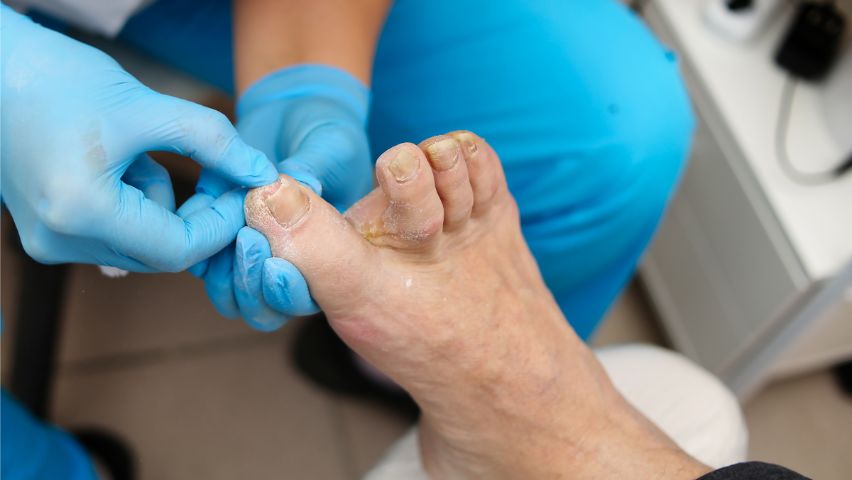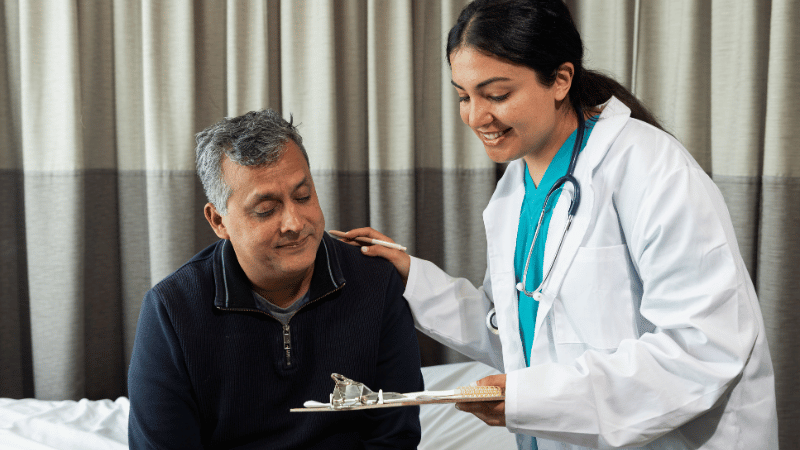Your toenails may seem insignificant, but they can offer valuable clues about your overall health. For example, if your toenails stop growing, it could indicate poor circulation or other health issues, such as diabetes or peripheral artery disease (PAD).
If you’ve noticed changes in toenail growth along with other symptoms, such as leg pain, numbness, or cold feet, it may be time to assess your vascular health. USA Vascular Centers offers a quick risk assessment test to determine if your symptoms could be associated with PAD in order to learn more about proactive steps you can take to protect your vascular health.
Vascular Health and Toenail Growth
Poor circulation in the lower extremities can severely inhibit hair and nail growth. The nail bed is supplied with nutrients by tiny blood vessels and need to receive adequate oxygenated blood from the arteries in the leg for continued nail growth.
Common vascular conditions linked to slow toenail growth include:
Peripheral Artery Disease (PAD)
Peripheral Artery Disease (PAD) is a serious vascular condition caused by plaque accumulation in the arteries. When the plaque builds up, it restricts the free flow of oxygenated blood to your lower extremities, which can cause leg pain, poor wound healing, and slow toenail growth.
Diabetes
Individuals with diabetes struggle with high glucose levels, chronic inflammation, neuropathy, and high blood sugar levels. These underlying health issues can damage blood vessels and restrict blood flow to the legs or feet.
Poor Circulation
Poor circulation can limit the flow of blood, oxygen, and nutrients to the toenails. This is a common symptom of vascular conditions such as varicose veins, blood clots, atherosclerosis, and PAD.
Vascular conditions should not be ignored; if you’re experiencing poor circulation, schedule a screening at USA Vascular Centers to ensure an accurate, early diagnosis.
Common Causes of Toenails Not Growing
Slow toenail growth is not always a cause for concern. Other common health reasons your toenails may have stopped growing include:
- Age-related changes
- Nutritional deficiencies
- Fungal infections
- Trauma to the toenail
- Ingrown toenails
Even if your toenail growth has only slowed, it’s still wise to schedule an appointment with a vascular specialist at USA Vascular Centers to rule out any serious vascular conditions.
Symptoms That Could Indicate a Vascular Problem
Individuals who are diagnosed with PAD or a serious vascular condition may experience other symptoms besides slow or non-existent toenail growth. Some common symptoms include:
- Cold Feet and Toes: Cold feet and toes are a common sign of poor circulation or a blockage in the arteries and may be accompanied by a tingly or numb sensation.
- Discoloration of Toenails: Nails with a yellow or brownish tint can be caused by poor circulation. Individuals might also notice shiny, dry skin on their legs or pale or blue-colored toes.
- Pain in the Feet: Aching, tingling, or cramping in the legs during light activity, which is relieved by rest, may indicate intermittent claudication, a key symptom of PAD. If PAD progresses to critical limb ischemia (CLI), pain may persist when resting.
Poor toenail growth can be a sign of moderate to severe PAD. If your toenails have stopped growing, don’t wait for your symptoms to worsen. Consult a specialist at USA Vascular Centers if you’re experiencing any of the symptoms above.
CALL TO SCHEDULE A CONSULTATION
What To Do If Your Toenails Aren’t Growing
If you’re experiencing slow toenail growth with other risk factors or symptoms, consider scheduling a consultation with a vascular doctor for a screening and early diagnosis.
While there isn’t a cure for PAD, early treatment can effectively manage symptoms and slow the progression of the disease, improving quality of life.
At USA Vascular Centers, we offer three non-invasive PAD treatments:
- Angioplasty: A tiny balloon is inflated to open the artery and compress the plaque against the artery wall.
- Stent Placement: Following an angioplasty, a mesh stent may be placed in the area to prop the artery open.
- Atherectomy: Accumulated plaque is safely removed from the arterial walls using a thin tube with a specialized tip.
In conjunction with treatment, your vascular doctor may recommend diet changes or physical activity to help manage your symptoms. Although lifestyle modifications can relieve some discomfort associated with PAD, they are not a standalone solution for addressing a serious vascular condition.
Contact USA Vascular Centers Today
If you’ve been worried about your toenails not growing, schedule a time to discuss your health concerns at USA Vascular Centers. Our expert doctors look forward to helping treat vascular issues like PAD that cause discomfort.
Schedule an appointment online today or give us a call at 888.773.2193. We offer affordable payment options and accept most insurance, which can be verified in real time using our online scheduling tool below.
Frequently Asked Questions
Is it normal for toenails to not grow?
While toenail growth can slow down as you age, if you find that your toenails are not growing at all, it may be a sign of an underlying condition. Conditions like peripheral artery disease, fungal infections, or nail injury can all stop toenail growth, so you should consult a doctor to find the underlying cause.
Can poor circulation cause toenails to fall off?
Severe disruption of the blood supply to the toenails can cause them to crumble and break off. Poor circulation also increases the likelihood of fungal infections in the nails, which can cause them to break.
What nail changes are usually signs of poor circulation?
If you have poor circulation in the toenails, you may notice that your nails are more brittle, pale or bluish in color, or thicker. You might also find that toenail growth on one foot is slower than the other. When circulation is severely compromised, the toenails may stop growing completely. If you experience any of these nail changes, contact USA Vascular Centers.



